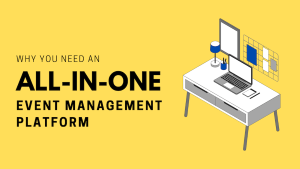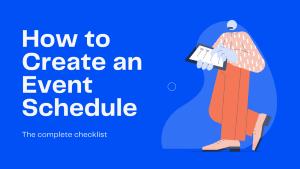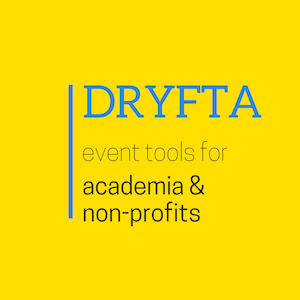There are a lot of details to nail down when you are organizing an event or conference. What structure do you use, how do you handle a networking event, how long should speakers be on for, and how many intervals should you include? These are all excellent questions that deserve an answer, and while there is no single ideal way to run an event, you can use scheduling best practices to create event schedule for your next conference and ensure your guests get what they need out of their attendance.
This article goes over the core concepts you will need to focus on when using your event scheduling software for your next conference.
What You Will Need to Create Event Schedule
You will come across many industry-specific terminologies when using an event schedule builder. Here are some of the most important terms you should be familiar with.
Ancillary Events
Event organizers may allow their sponsors to host supplementary events. You will also see them listed as advisory board meetings, focus groups, social events, or press events.
Breakout Session
A breakout session is the “mini-me” of meetings. They usually happen in a smaller room than the main event. Attendees get the option of going to one of many breakout sessions happening simultaneously.
Conference
A conference is a meeting that delivers focused, relevant content to a highly targeted audience. They can be held over a single day or over several days. You will also see them referred to as symposiums, user conferences, or internal conferences.
Keynote Speaker
The keynote address is the most important moneymaker of the event. Consider these to be the headliner that attracts the crowd. Because they are your most essential speakers, they are usually in high demand, so you need to be flexible with their schedule to ensure they can be booked.
Tracks
Larger conferences can have many breakout sessions, which are usually separated into different themes called tracks. Tracks make it more straightforward for your guests to find breakout sessions that are of more relevance or interest to them.
Trade Show
A trade show is organized around a specific industry, such as a woodworking event, where industry professionals and suppliers interact with participants and display their goods and services.
Sessions, Activities, and Entertainment
Before you start filling out your event schedule builder, create a comprehensive list that includes everything you plan to have at the event. Doing this will help you accurately plan and organize everything that needs to happen and when.
Things to add to your list include:
- Keynote speakers
- sponsor ancillary events
- entertainment sessions
- catering
- beverages
- Breakout events
While your list is getting filled out, keep in mind how long each item will require. You will eventually need to consult with your vendors and speakers as your schedule gets more detailed.
Don’t forget to include some free time between sessions. Many of your visitors will be there to network with their peers, which can’t happen if they are shuffled from one event to the next without a break. Sponsors will benefit from the foot traffic as they will get to engage with attendees who have some free time before their next meeting.
Event Duration
Events will fall into a specific category determined by their duration, including:
Single Day, One Track
Excellent for a focused agenda and a targeted audience
Single Day, Multiple Tracks
Good for when you have multiple themes to cover or more content than you can present in a single day.
Multiple Days, One Track
Great when you need to cover a lot of content over various agendas that you can’t fit into a single day. They are also suited to ensuring that every attendee can get to every session.
Multiple Days, Multiple Tracks
Large conferences or events with more than a single keynote speaker and lots of content covering numerous agendas. The only way to deliver so much content is to host the event over several days.
When you understand which format your event fits into, you will make more efficient use of your event scheduling software.
Event Planning
When you know how long your event will need to be to deliver all the content you have planned, it’s time to focus on the planning process.
One Day Event
A one-day event can be viewed as a regular working day. For example, start the event at the traditional workday starting times, which could be 8 or 9 a.m. depending on your demographic. This will seem logical and doable for your attendees.
Try to keep sessions to no longer than 90-minutes each, with breaks that coincide with traditional meal room breaks at the office.
Vary your speakers and event formats throughout each ninety-minute block, with each session lasting 30 to 45-minutes. Doing it this way should keep things fresh and interesting.
Break times should be long enough for your guests to have a bathroom break and eat a meal, and allow enough time to mingle. Consider slotting in an interactive session after the lunch break to re-engage with sluggish minds.
Multi-Day Events
You use your event schedule builder to plan each day of a multi-day event much as you would a single-day event.
If you know some of your attendees will have trouble getting to see a keynote speaker on time, you can schedule your start 10 to 15 minutes before they are set to appear. This should be enough time for most stragglers to arrive without interrupting the presentation, while the earlier arrivals can mingle and enjoy a tea or coffee.
Most attendees will be experiencing information overload by the last day of the conference and will appreciate an earlier finishing time. This way, they can get back home earlier and enjoy a brief respite before returning to work the next day.
Organize Your Content
While developing your list of sessions, entertainment, catering, and activities, you will need to start creating structure.
Time chunking is blocking out chunks of time in your event schedule builder for each activity at your event. It’s a very effective strategy that can be approached a few different ways, including:
- 60-minute sessions with a 15-minute intermission
- 45-minute sessions with a 15-minute intermission
- 30-minute sessions with a 10-minute intermission
One of the most popular time chunking strategies uses the 45 / 15 ratio because it’s a neat block of 60-minutes that is relatively easy to manage. However, the time chunking method you use will depend a lot on your audience, your speakers, the types of activities, and the content you have planned.
There’s no reason you have to stick to one format for the entire event duration, as it might be beneficial to mix it up over a multi-day event.
Prioritize Your Non-Negotiables
One of your first considerations for a schedule should be your primary keynote speaker. Your main guest speaker is likely your biggest drawcard for the event. It’s these people your guests will be the most interested in seeing, so you may need to bend over backward to accommodate their schedule and ensure you can get them on stage.
Keynote speakers are busy people, so you will need to weave your itinerary around their schedules. Their window for appearing on stage is likely very small before they need to be off to their next engagement. If they have to be on a flight at 5 p.m, you need to make sure they are off your stage and on the way to the airport at 3 p.m.
Other compromises you might need to make are meal times. Keynote speakers may have strict schedules and could even stipulate a specific time for breakfast and lunch.
When dealing with the main presenter for your conference, you often don’t have much flexibility in when they can appear, so always plan to plan around them.
Vendor Timing
The next stage of your event schedule will work around your vendors’ timeline. Event suppliers help you create a more engaging and memorable event, which means they need to have a good idea of what’s happening and when.
When you work closely with your vendors, working them into your schedule won’t be as difficult as it seems. They will have an excellent idea of how long everything takes and will be more than happy to fill you in with the details.
Schedule a meeting with each of your vendors to discuss your timeline, and find out how much time they will need for the parts of the event they will be involved with.
For example, when you are hosting an event at a physical location, you should ask your caterer how long it will take to prepare and serve a three-course meal for however many guests you plan on having.
You will need an AV team for both physical and hybrid events, so you should use your event scheduling software to block in the time they need for running wires, setting up cameras, and configuring audio equipment. They may also need some time for testing to ensure everything will go smoothly.
A hybrid event will need technicians to set up streaming and recording software. It’s a highly technical process, so ensure you leave enough time for them to set up and test their equipment and do a dry run to work out the kinks.
Keep in mind that event timelines can significantly affect costs. For example, if one of your vendors needs access to the event venue a day before the event to set up, you may need to book it for an extra day, which will impact your budget.
Create Event Schedule That Makes Sense for Attendees
It’s always tempting to try and cram as many activities into your event as possible, so attendees have a plethora of choices. Sometimes, having fewer events creates a higher caliber event overall.
Once you have your schedule mapped out in your event schedule builder, walk away from it for a day or two. When you next revisit the plan, it will be with fresh eyes. Areas where you could make improvements are more likely to jump out at you.
You could also share the schedule with someone else not involved with event management to get their objective, unbiased opinion.
Consider the following when blocking out your times:
- Do your guests have enough time to relax between events?
- Do attendees have enough time to travel from one event to another?
- Have you created any overlaps?
- Are there simultaneous events where attendees would like to attend both?
There are likely to be many more considerations when creating a suitable schedule for your attendees, but the important takeaway is to always keep their wants and needs in mind while using the event scheduling software.
Crafting Your Event Schedule with Dryfta
Creating an engaging, interactive, and efficient event schedule can be challenging, but it doesn’t have to be. With Dryfta’s event scheduling tools, you can seamlessly create event schedule on both your website and mobile event app. From personalized schedules to real-time notifications and CE credit tracking, Dryfta empowers event organizers to deliver exceptional experiences for attendees.
Here’s how Dryfta revolutionizes event scheduling and management with features that engage participants, enhance organization, and drive event success.
Dynamic and Customizable Scheduling Features
Dryfta takes event scheduling to a new level with its robust, user-friendly features designed for efficiency and flexibility.
Key Features at a Glance:
- Display Parallel Tracks: Showcase multiple sessions happening simultaneously, making it easy for attendees to choose what interests them most.
- Filter by Categories: Allow participants to sort sessions by speaker, track, format, or time slot for effortless navigation.
- Personalized Schedules: Enable attendees to curate their own schedules by adding sessions they want to attend.
- Session Check-Ins: Let attendees check into sessions to earn CE credits or verify attendance. Attendees can self check-in or volunteers can check-in and check-out attendees using QR code scanner.
- Social Sharing: Amplify your event’s reach by allowing attendees to share sessions directly on social media platforms.
Boost Engagement with Real-Time Interaction
Dryfta enhances attendee engagement through its suite of interactive tools that work seamlessly across virtual and in-person events.
Interactive Virtual Meetings
Host immersive virtual meetings with up to 500 participants, complete with audio, video, and screen-sharing capabilities. Livestream these sessions directly on your event website for maximum accessibility.
Engage Through Live Polls and Q&A
Enable real-time interaction with live polls, file uploads, and Q&A sessions. Notifications alert attendees to participate, keeping them engaged and informed throughout the event.
Attendance Tracking and Reporting
Efficient attendance management is crucial for understanding your event’s impact and planning future sessions. Dryfta makes this process seamless with advanced tracking tools:
- Attendance Reports: Easily download attendance data to analyze participation levels across sessions.
- CE Credit Management: Manually or automatically allocate CE credits to attendees based on session check-ins.
- Waiting List Monitoring: Track and manage waiting lists to gauge session popularity and make adjustments as needed.
Organized Scheduling with Tracks, Formats, and Locations
Dryfta’s Tracks and Formats editor ensures that you create event schedule which is not only organized but also accessible.
Session Customization Options
Every session can be tailored with details like:
- Date, time, venue, and track.
- Downloadable presentation files.
- Attendee capacity limits.
Conflict-Free Scheduling
Dryfta’s automated conflict management system ensures there are no overlapping sessions, creating a smooth experience for attendees and organizers alike.
Monetizing Your Event Schedule
Dryfta’s ticketing and monetization features integrate seamlessly with the event schedule, creating opportunities to boost revenue while enhancing attendee experience.
1. Paid Workshops
Offer specialized workshops alongside your main event. Assign specific ticket types to these workshops, enabling attendees to purchase access directly from the session page.
2. On-Demand Videos
Extend the reach of your event with on-demand videos of pre-recorded presentations. Not only does this offer flexibility to attendees who couldn’t join live, but it also generates additional revenue streams.
3. Webinars and Virtual Events
Host and monetize webinars directly within the Dryfta platform. Attendees can purchase tickets and access sessions seamlessly, simplifying the process for both parties.
4. Session-Specific Ticketing
Set premium pricing for high-value sessions, such as those featuring industry leaders or exclusive content, giving attendees the flexibility to pay for what interests them most.
Enhancing Attendee Insights Through Analytics
Dryfta provides comprehensive analytics to help you understand attendee behavior and optimize your event.
Key Metrics to Monitor:
- Session Popularity: Identify which sessions attract the most interest and attendance.
- Engagement Levels: Track participation in live polls, Q&A sessions, and live chats.
- Ticket Sales Data: Understand purchasing patterns to refine your pricing strategy.
- Post-Event Feedback: Use session-specific surveys to gather insights on content quality and speaker performance.
Real-Time Resource Management
Dynamic scheduling doesn’t just benefit attendees—it’s a powerful tool for organizers. With Dryfta’s real-time data, you can:
- Reallocate resources to sessions with high demand.
- Adjust seating and A/V setups on the fly.
- Optimize your schedule to maximize attendee satisfaction.
Leveraging Session Surveys for Future Success
Feedback is the cornerstone of continuous improvement. Dryfta makes it easy to collect session-specific feedback through surveys on the event website and app. Gather insights on:
- Content relevance.
- Speaker engagement.
- Overall attendee satisfaction.
These insights can guide future event planning, ensuring your sessions remain impactful and valuable.
Tips to Create Event Schedule Using Dryfta
- Personalize the Experience: Use Dryfta’s session recommendation feature to suggest sessions based on attendee interests.
- Maximize Visibility: Leverage color-tagged tracks and social sharing buttons to improve schedule navigation and event reach.
- Enable Real-Time Notifications: Keep attendees updated on session changes or announcements with instant push notifications.
- Encourage Networking: Foster connections among attendees with Dryfta’s networking tools, enhancing the overall event experience.
- Implement Secure Check-Ins: Use built-in scanner's authorized check-ins features to ensure only legitimate attendees gain access to sessions and CE credits.
The Future of Event Scheduling
Dryfta’s event scheduling software is designed to make event planning effortless while enhancing attendee experience. From intuitive schedule creation to real-time interaction and robust analytics, Dryfta equips event organizers with everything they need to host memorable, engaging events.
Whether you’re planning a corporate seminar, academic conference, or virtual summit, Dryfta helps you create event schedule that drives engagement, maximizes revenue, and delivers lasting value to participants.
Ready to Simplify Your Event Scheduling?
Start creating an event schedule that stands out. Click here to explore Dryfta’s features or request a personalized demo today! Transform your event planning experience and exceed attendee expectations with Dryfta.







